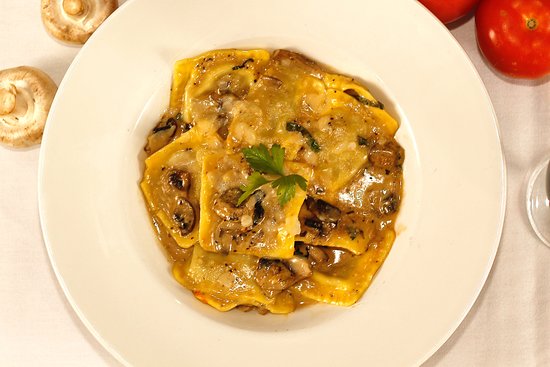Pasta
Beef cheek ravioli

This simple ravioli recipe uses tender braised beef cheek (or ox cheek) as a filling. You can increase the quantities of the beef and have it for a separate meal, or use it as a ragu for pappardelle. It makes a showstopper starter for six or meal for four.
Ingredients
For the beef cheek filling
- 800g/1lb 2oz beef cheeks
- 2 tbsp plain flour
- 2 tbsp vegetable oil
- 1 large onion, diced
- 2 carrots, chopped
- 1 stalk celery, chopped
- 2 garlic cloves, finely chopped
- 1 tbsp tomato purée
- 200ml/7fl oz red wine
- 150ml/5fl oz beef stock
- salt and freshly ground black pepper
For the fresh pasta
- 200g/7oz ’00’ flour, plus extra for dusting
- 2 free-range eggs
- semolina flour, for dusting
- salt
For the sage butter
- 60g/2¼oz salted butter
- 16 small sage leaves
- freshly ground black pepper
- freshly grated Parmesan, to serve
Method
-
To make the beef cheek filling, roll the beef in the flour and pat off any excess. Heat the oil in a large casserole over a medium heat, add the meat and cook until well browned all over. Remove the meat and set aside.
-
Preheat the oven to 150C/130C Fan/Gas 2. Add the onion, carrots and celery to the casserole and cook for around 8–10 minutes, until the onions are just soft. Stir in the garlic and tomato purée. Add the beer (or red wine) and stock and return the meat to the casserole. Bring to a gentle simmer, cover with the lid and place in the oven. Cook for around 4 hours until the cheeks are tender. (You could also cook them in a slow cooker for 8 hours or in a pressure cooker at high pressure for 1 hour.) Season with salt and pepper, to taste, and set aside to cool completely.
-
To make the pasta, place the flour in a mound on a large clean work surface. Make a well in the centre and add the eggs. Gradually draw the flour into the eggs with your hands to create a dough. The dough will become less sticky as it comes together. Form into a ball and knead for around 8 minutes until smooth, elastic and when you drag your thumb across the dough it doesn’t tear. Place in an airtight box and chill in the fridge for 30 minutes.
-
Divide the dough into two equal pieces and place one piece on a work surface dusted with semolina. Make sure the other dough piece is covered with a damp tea towel to prevent it from drying out. Roll the dough into a rectangle that is about 5mm/¼in thick.
-
Dust the dough with flour and feed it through a pasta machine on the widest setting. Fold and feed through again. Repeat the process four or five times. Pass the dough through the pasta machine rollers, decreasing the setting until the pasta sheets are rolled in the final, narrowest setting. (You can make the ravioli slightly thicker and with more bite by stopping at the penultimate setting, and this will be slightly easier to fill without poking a hole in them.) Place the pasta sheets on a clean work surface, lightly dusted with semolina.
-
Lift the beef cheeks and some of the vegetables from the sauce with a slotted spoon and put into a bowl. Fork through the mixture to shred the beef into small pieces, using some of the cooled cooking liquid to moisten, until you have a mixture that holds together but doesn’t feel too dry. (The extra beef cheek mixture can be frozen for another pasta dish or used as part of a beef soup or stew.)
-
Place 1 heaped teaspoon of beef filling at intervals in a straight line along the length of one half of the dough strips. Space them about 4cm/1½in apart and about 2cm/¾in from the edge.
-
Lightly brush the pasta with water between each mound and down the long edge of the pasta. Fold the dough lengthways over the filling and then press gently over the filling to flatten slightly and seal. As you seal each square, work to eliminate any airfrom the ravioli, as this will cause them to burst in the boiling water during cooking.
-
Trim the edges with a pasta cutter wheel and cut into separate ravioli squares. Check that each ravioli is well sealed and set aside on a tray dusted with semolina. (At this point the ravioli can be covered and refrigerated for up to 4 hours, or frozen on the tray. Decant the frozen ravioli to a sealed box or bag to store for up to 3 months.)
-
To cook, fill a large saucepan with water, add 1 tablespoon of salt and bring to the boil.
-
Cook the ravioli in batches for 1–2 minutes, until the pasta is cooked and the filling has heated through properly. Drain thoroughly.
-
To make the sage butter, melt the butter in a small frying pan with sage leaves. Fry gently until the sage leaves start to sizzle and the butter starts turning golden brown. Add some black pepper. Turn the ravioli in the sage butter and serve with Parmesan.

Beef cheek ravioli
